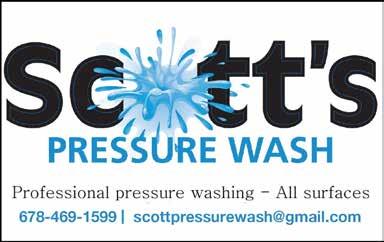
5 minute read
One Man’s Opinion: Why the Debt Ceiling Still
Matters
By Bill Crane
Among the aspects of our republic that our founders got right is the separation of powers of our three branches of government: executive, legislative, and judicial. President George Washington was adamant that we not create a system or position of royalty, or mimic the monarchies of Europe of that day. The Congress, or “the people’s house,” would contain two chambers, hold the power of the exchequer (the budget and spending), and craft the laws of the land. The judicial branch would oversee disputes, then between states, and have purview over criminal acts by members of either the executive or legislative branches. The executive branch and later the White House would manage foreign affairs, oversee our military and acts of war as Commander in Chief, execute the laws of the land as written by Congress, and oversee the then paltry federal bureaucracy.
Our national debt expanded exponentially during the Civil War and later the World Wars. However, it was not until October 22, 1981, during President Ronald Reagan’s first term and first year in office, that our collective national debt reached the $1 trillion mark. Almost forty-two years later, that aggregate debt is over $31 trillion. Just for the visual, here is what one trillion dollars looks like: $1,000,000,000,000.00.
The power of the executive branch has grown alongside the federal government’s reach, with many of the most significant expansions occurring during the four terms of Franklin D. Roosevelt, and later the Great Society programs introduced by Lyndon B. Johnson. The most prominent drivers of federal spending today are Social Security and Medicare. It is worth noting that House Republicans are not proposing cuts or reductions in either of those third rail programs in their proposal to raise our debt ceiling again.
All spending bills originate in the U.S. House. Once passed, bills move on to the U.S. Senate, and later conference committees, and if passed as amended by both chambers, on to the president’s desk. Congress and its combined 535 members have other responsibilities, but spending over- sight and management is its first and foremost priority.

Well ahead of the current looming debt ceiling cliff, House Republicans have proposed a reasonable package of spending cuts of $4.8 trillion. This is primarily accomplished by clawing back UNSPENT Covid Emergency Relief Funding – doled out by two administrations, one Republican and one Democrat – and rolling discretionary federal spending (non-social/transfer payment programs) back to 2021 levels, and adding some modest work requirements for able-bodied adults to receive continuing welfare assistance. It is again worth noting that during the Clinton/Gingrich budget battles of the mid-90s, which produced those balanced budgets and one year with a revenue surplus, the most significant compromise and budget balancer was a rework of Welfare into what was then referred to as Workfare, and officially Temporary Assistance for Needy Families (TANF).
Democrats held majorities in the U.S. House during Reagan’s first term, portions of the George H.W. Bush Administration, the last two years of George W. Bush’s second term, and the back half of the Trump years. Strangely though, House Democrats also did not roll over and automatically raise the debt limit in those years either. The current proposal would again raise the debt ceiling but also bring congressional
Continued on page 20 nity is invited to join in on the fun.

For instance, you might hear a lot of buzz about an author coming to discuss her book on June 27th at 11:00 a.m. The author happens to be a sister of a resident, and everyone is excited to hear her read. Or you might enjoy something like the luau that will take place on July 19th, where you can not only enjoy some delicious food, but also interact with an incredible community. No matter what your interests are – or your age – The Sheridan at Eastside provides multiple events year-round that are open to everyone who wants to participate.
If you have questions, just give The Sheridan at Eastside a call at (678) 668-8194. Julia Westover along with Sales manager Renee Sanders devote their time to answering everyone’s questions about what to expect, so don’t hesitate to voice concerns, double check some details, or schedule a tour of the community.
Every phase of life has a place in Gwinnett. Make your next one the best it can be at The Sheridan at Eastside.
More information at www.seniorlifestyle.com/property/georgia/ the-sheridan-at-eastside
Kid’s Corner: Six Smart Ways to Save Money for Your Kids
By Our Town Gwinnett Staff

While there are many ways to set your kids up for a successful future, money in the bank is one of the most powerful financial tools you can pass along. Every dollar you save or invest can help your child create a productive and stable foundation for many years to come.
When it comes to saving for your kids, the sooner the better. Building up funds now can ensure kids will have less to worry about as they get older and can open up more financial opportunities. To help you get started, consider these several ways to save wisely for your kids.
1. Open a college savings account:
If higher education is in your child’s future, consider a 529 savings plan. This is a tax-advantaged investment plan that can be opened as soon as your child is born. The money grows tax free and can be withdrawn without taxes. There are two types of 529 plans: prepaid tuition and education savings. Prepaid tuition plans can purchase credits at a participating university and lock in current tuition costs. An education savings plan is an investment account where funds are designated for qualified college expenses. Be sure to consult a tax advisor to assist with your specific circumstances as this is only intended to provide general information.
2. Invest in a home:
Purchasing a home can be one of the most secure and highest-return investments you can make for your children, especially in today’s housing market. A home can be passed down through generations or sold when the value has increased.
If you’re looking to invest in a home for your children, consider manufactured housing. Manufactured homes attached to a permanent foundation appreciate at an average rate of 3.4%, while traditional homes appreciate at an average rate of 3.8%. So, while manufactured homes may not appreciate at the exact same rate, they’re close!
3. Use Roth IRA contributions:
If you have a Roth IRA account, you can use some of the funds to pay for qualifying education expenses. If your account is at least five years old, you can withdraw up to your original contribution amount. Be sure to consult a tax advisor to assist with your specific circumstances.
4. Allow Kids to use Debit Cards:
Consider teaching your kids money management skills early on by allowing them to use a debit card co-owned by you. If you have teenagers who earn an income, this is a great tool for learning how to deposit checks, set aside money for savings, and more.

5. Open a high-yield Savings Account:
A high-yield savings account can be a great place to stash birthday and holiday gift money over the years and watch it continue to grow. This type of account can typically be co-owned and managed by parents until your child is responsible enough to manage it on their own.
6. Set aside money in a trust fund:
Putting money for your kids in a trust doesn’t have the same tax
Continued on page 12




